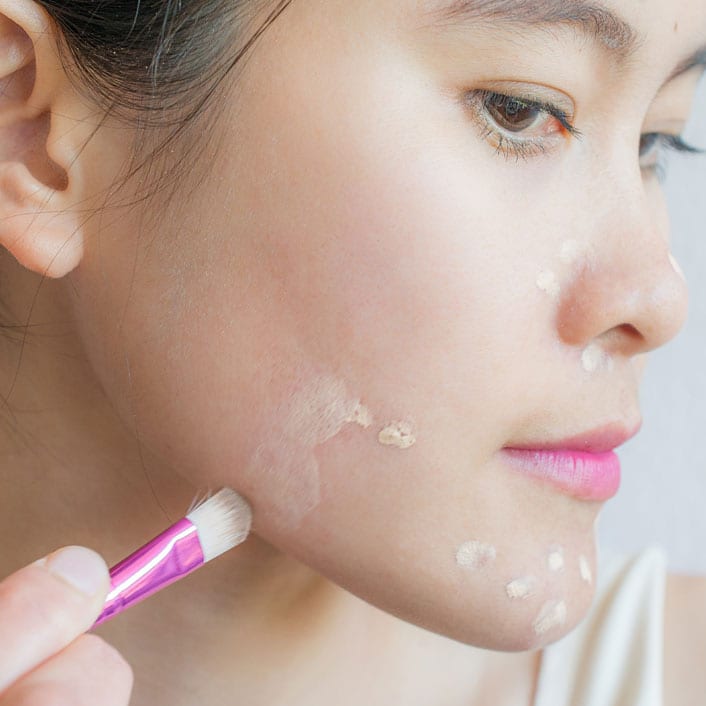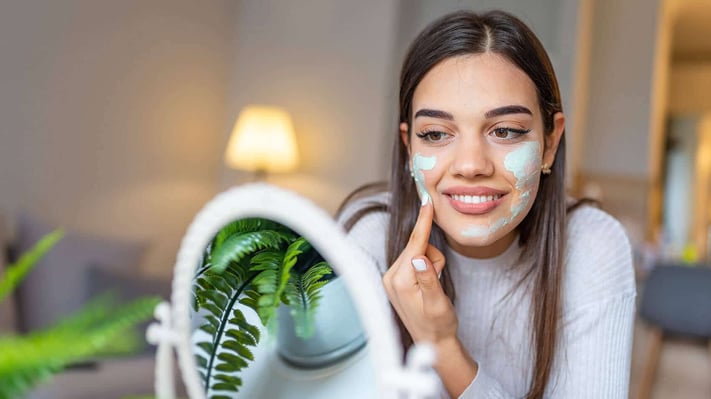How to Reduce Large Pores with Makeup and Skin Care
People of every age and ethnicity suffer from large pores. This genetic condition may lead to oily skin that is more acne-prone. While skin oil counteracts many visible signs of aging, it also causes pores to become larger over time. Learn about the characteristics and causes of enlarged pores, ways to keep skin clean and healthy and how to reduce large pores with skincare and makeup.

Every oil pore has a sebaceous gland that produces sebum. The hair that grows from pores helps to support the passage of oil to the skin surface to create a barrier layer of healthy moisture. Each person has approximately five million hair follicles on the body, and about 20,000 pores on the face alone. The pores that are noticeably enlarged, clogged or inflamed tend to only be a relatively small percentage of the total number of pores.
Although only a few pores may be visibly enlarged, many people dislike this skin condition and it tends to worsen with age. It is important to understand how to reduce large pores with the right makeup and skincare.

Men have larger pores than women. Pore size is also affected by hormonal changes. Pores may appear larger or smaller at different points in a women’s menstrual cycle and during pregnancy or menopause. These shifts may also coincide with episodes of oily skin or acne flare ups. These changes in pore size may or may not be visible to the eye. In terms of how to reduce large pores, increases in pore may become more noticeable without proper skincare and the best makeup for large pores.
Maintaining tight skin with less visible pores gets more difficult with age. Collagen starts to break down over time which diminishes skin elasticity and leads to crepey or sagging skin and wrinkles. As this occurs, pores may dilate or stretch into teardrop shapes.
The same factors that intensify signs of skin aging also contribute to enlarged pores, particularly sun damage. When skin becomes inflamed by ultraviolet, infrared and visible light damage, scorched cells tend to accumulate around the edges of pores, making them more apparent.
A number of habits can contribute to larger pores. Regular or prolonged exposure to sun without sunscreen or protective clothing or the use of tanning beds can damage skin by causing collagen to break down prematurely. Smoking cigarettes exposes your system to nicotine, which dries out skin and contracts the blood vessels that deliver oxygen and nourishment to skin. A few short answers to the question of how to reduce large pores include drinking more water, eating healthy foods and washing your face at least once a day.
A few minor lifestyle changes can prevent pores from becoming clogged. Change pillowcases and sheets at least weekly. Skin cells, products and debris accumulate on linens and can end up on your skin while you sleep. This is another reason to always wash your face and remove makeup before going to bed. Avoid letting the screen of your phone make direct contact with your face. Phone screens are hotbeds for bacteria and skin oils.
Never wear makeup during workouts, even the best makeup for large pores. Sweat can become trapped and form buildup that blocks pores and increases breakouts. Avoid touching your face except immediately after washing your hands and never pick at blemishes.
Pores become inflamed when oil mixes with dead skin and other substances and forms a clog. If this buildup makes it difficult for more oil to flow freely from the sebaceous gland, pores may get larger to help oil escape. Clogged pores lay the basis for breakouts.
Oil trapped in a pore oxidizes upon exposure to air and forms blackheads. The color of these spots is actually an optical illusion. Oxidized sebum extracted from pores is usually white. Whiteheads form if C. acnes bacteria are present. Your skincare routine should focus on keeping pores clear, encouraging skin cell turnover and balancing oil levels. Makeup can provide temporary coverage that reduces the appearance of enlarged pores.

Start with clean skin. If skin tends to be oily, prime and hydrate skin by applying micellar water toner. Apply moisturizer and allow the product to sink in before putting on a pore-reducing makeup primer. If you choose to use silicone-based primer, it is necessary to thoroughly cleanse or double cleanse skin every night. Most makeup artists also recommend exfoliating at least twice a week to prevent pores from becoming clogged.
Products with matte finishes are the best makeup for large pores or skin that tends to become oily. Blend and buff liquid or powder matte foundation with a makeup blender, sponge or clean fingertip. Build up coverage over areas of discoloration or large pores. Limit the amount of product you use, as too much can cause skin to look cakey and lead to more buildup in pores.
If you have other skin issues such as breakouts or discoloration, you can also use a matte-finish concealer. Medicated concealers may be useful for treating breakouts while providing coverage. Any face makeup you use, from primer to foundation, concealer, blush, bronzer or highlighter should be non-comedogenic or oil-free. Never smear or rub makeup during application, as this can cause a silicone primer and any cosmetics layered on top to ball up or peel off.
Set a look with finishing powder. A translucent, soft-focus formula is ideal for blurring away large pores. You may also want to maintain healthy moisture levels with a facial mist or setting spray. The best makeup for large pores can discourage sebum glands from overproducing oil. Once you have on a full face of makeup, blotting papers are helpful for managing excessive oil levels and keeping shine under control.
You can get a pack of blotting papers that is easy to bring with you anywhere. If you don’t have a square of blotting paper handy, dab skin with a single layer of tissue to absorb oils and emollients. Makeup is more likely to create the appearance of a smooth, flawless complexion if you follow a daily skincare routine to balance oil levels and keep pores clear.

Many skincare tips suggest cleansing the face with warm water and finishing with cold water to close pores. This advice is not entirely accurate. Pores do not open or close, but dilate from narrow to wide or wide to narrow similarly to a camera lens. Exposure to steam does not open a pore so much as loosen up the oil inside, which makes extraction easier.
If the products you use leave your skin too dry, sebaceous glands will go into overdrive to replenish moisture levels. Washing or treating skin too frequently or using a harsh cleanser can also cause pores to appear larger. People with oily skin or large pores may prefer gel or water-based formulations that are oil-free. The approach you take to how to reduce large pores should not involve sodium lauryl sulfate or other harsh foaming agents that strip away every trace of natural oil.
Once or twice a week, you may want to treat oily skin with a mask containing clay or charcoal. These substances absorb excess oil, extract pore blockages and may minimize the appearance of enlarged pores. You can also apply a serum to firm skin or minimize pores in advance of moisturizer.
Skin with large pores should be treated with non-comedogenic moisturizer that will not clog pores. Follow with sun protection. In the evening, wash, treat and moisturize your skin again. You may want to use a retinoid treatment to stimulate cell turnover and keep pores clear while smoothing and tightening the texture of skin.
While it is best to upgrade your skincare routine to gentle, balancing products, you can also reduce the frequency with which you use harsh astringents, exfoliation treatments or oil-based masks to no more than once or twice a week. The best approach for how to reduce large pores includes exfoliating skin once or twice a week using physical or chemical methods.
Physical exfoliants include cleansers that contain tiny granules or scrubbing particles and powered face brushes. If you choose to use a physical method, always massage skin in circular motions. Physical exfoliation may cause more irritation than gentle alpha-hydroxy acid and beta-hydroxy acid treatments, which do not require agitation.
AHA and BHA work on the cellular level, with AHA brightening and smoothing the surface layer of skin and BHAs penetrating deeper to unclog pores. AHAs include several naturally sourced acids such as glycolic acid derived from sugar cane, lactic acid from milk, malic acid from apples, citric acid from citrus fruit and tartaric acid from grapes. The most common form of BHA is salicylic acid. Chemical exfoliants dissolve connections between cells and the skin surface to unclog pores and clear away dead skin cells.
Aestheticians and dermatologists also have a number of effective treatments for enlarged or clogged pores. An aesthetician can extract blackheads and pop whiteheads without damaging skin. You can also carefully use an extraction tool after bathing or showering when the oils clogging pores have been loosened. Improper use of an extraction tool can damage blood vessels or result in acne scars.
Ask a skin specialist about how to reduce large pores. Experts use treatments that involve creating micro injuries to reduce pore size. The natural repair process promotes production of collagen and elastin for denser, tighter skin with less visible pores. Laser treatments stimulate collagen production and fade acne scarring.
Microneedling can also be an effective way to achieve an immediate glow and develop a thicker epidermis that is less likely to show wrinkles. This non-invasive treatment can be done with a dermaroller or handheld roller covered in tiny needles or a powered pen device. Skin heals quickly with proper post-procedure skin care and may appear more plump and firm with smaller pores.
Laser and microneeding treatments should be performed or prescribed by skincare experts. Any physical equipment for creating micro injuries must be thoroughly cleaned to avoid spreading bacteria that cause acne or unnecessarily irritating skin.
AHA and BHA work on the cellular level, with AHA brightening and smoothing the surface layer of skin and BHAs penetrating deeper to unclog pores. AHAs include several naturally sourced acids such as glycolic acid derived from sugar cane, lactic acid from milk, malic acid from apples, citric acid from citrus fruit and tartaric acid from grapes. The most common form of BHA is salicylic acid. Chemical exfoliants dissolve connections between cells and the skin surface to unclog pores and clear away dead skin cells.
Aestheticians and dermatologists also have a number of effective treatments for enlarged or clogged pores. An aesthetician can extract blackheads and pop whiteheads without damaging skin. You can also carefully use an extraction tool after bathing or showering when the oils clogging pores have been loosened. Improper use of an extraction tool can damage blood vessels or result in acne scars.
Ask a skin specialist about how to reduce large pores. Experts use treatments that involve creating micro injuries to reduce pore size. The natural repair process promotes production of collagen and elastin for denser, tighter skin with less visible pores. Laser treatments stimulate collagen production and fade acne scarring.
Microneedling can also be an effective way to achieve an immediate glow and develop a thicker epidermis that is less likely to show wrinkles. This non-invasive treatment can be done with a dermaroller or handheld roller covered in tiny needles or a powered pen device. Skin heals quickly with proper post-procedure skin care and may appear more plump and firm with smaller pores.
Laser and microneeding treatments should be performed or prescribed by skincare experts. Any physical equipment for creating micro injuries must be thoroughly cleaned to avoid spreading bacteria that cause acne or unnecessarily irritating skin.
A combination of skincare products or treatments and makeup can reduce the appearance of large pores. Over time, pores may expand with age. Reducing the appearance of enlarged pores may eventually require professional skincare treatment.
Keeping pores clean and healthy and using gentle products to balance oil levels can make it easier achieve complete coverage with the best makeup for large pores. Make sure to use oil-free formulas or products formulated for skin concerns. No matter which makeup you use, it is important to clean skin in the evening if not twice a day.
Oil production levels will determine whether people with large pores should follow guidelines for how to reduce large pores or care for oily or acne-prone skin. Skin of any type or condition benefits from daily sun protection. Avoiding skin damage can limit the enlargement of pores and prevent other premature signs of aging.
How to Get Rid of Large Pores
What do you first notice when you look in the mirror? Most [Read More...]
Choosing the Best Pore Cleansing Mask to Get Your Glow Back
By Laura Bissessar Have you looked in the mirror recently and thought [Read More...]
How To Use The Best Makeup for Large Pores
For some of us, large pores are just a fact of life. [Read More...]
Why Large Pores Exist and What Skin Care Products and Procedures You Can Use on Them
If you don’t have enlarged-looking pores, you probably don’t think about them [Read More...]





